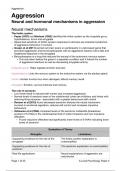Summary
Summary Aggression Complete Revision Notes (Psychology AQA A-Level)
Complete Aggression revision notes for AQA Psychology A-Level, written by a straight A* student. Includes PEEL paragraphs for every topic and diagrams where needed. Well organised and in order. Includes collated information from class, textbooks and online. Topics include: Neural and hormonal mec...
[Show more]




